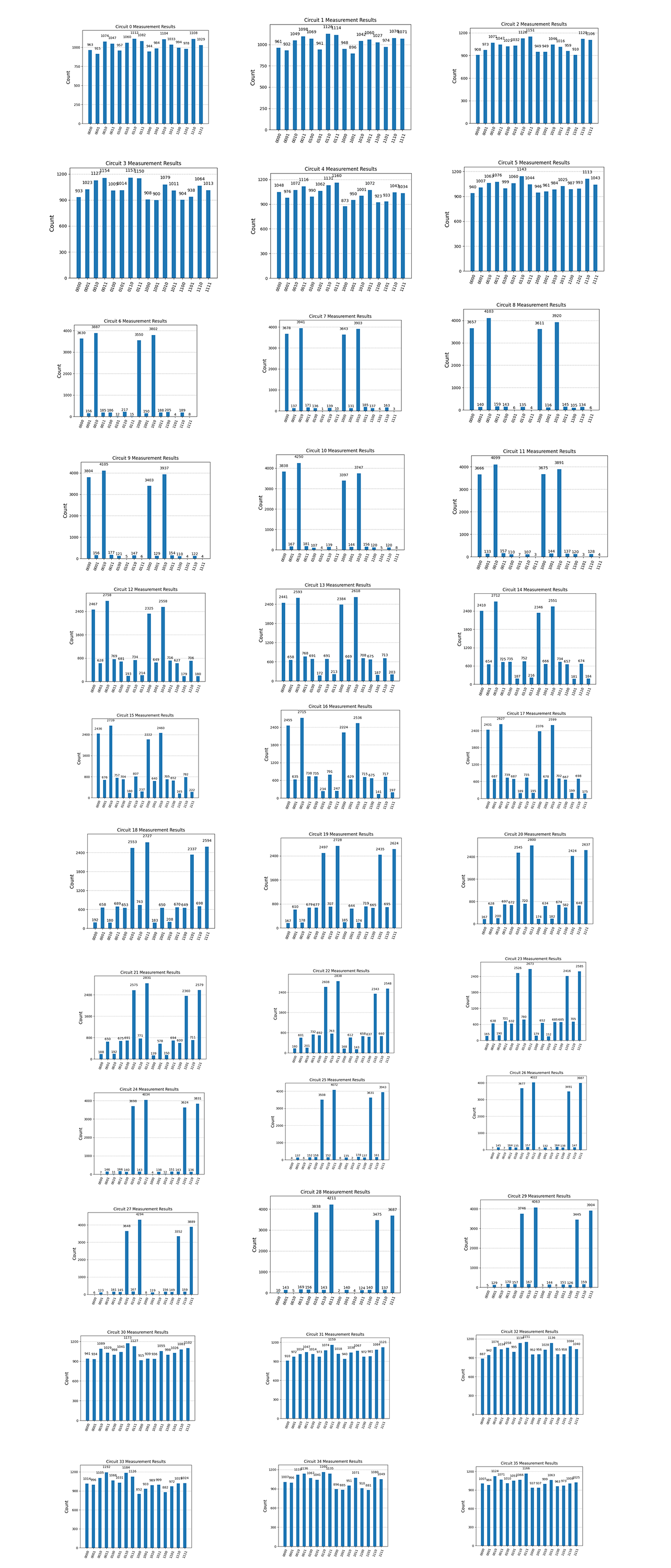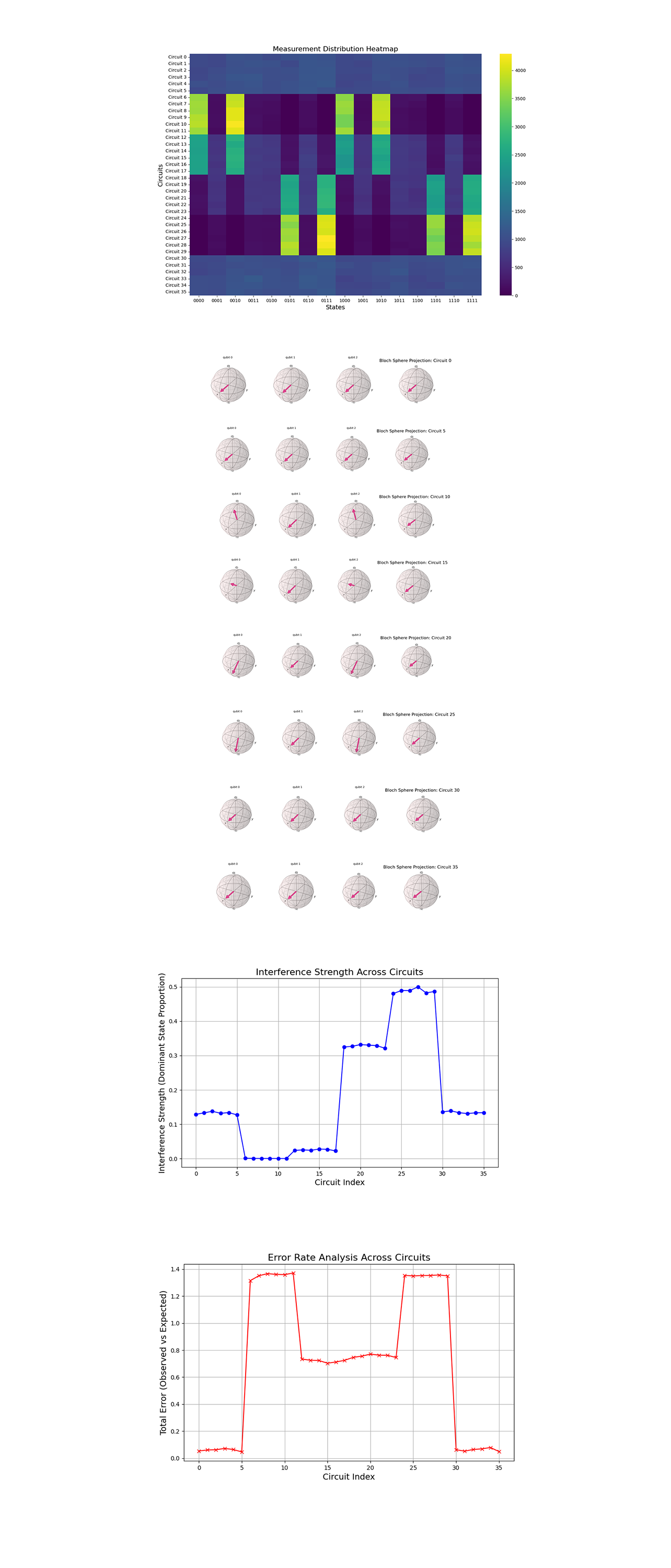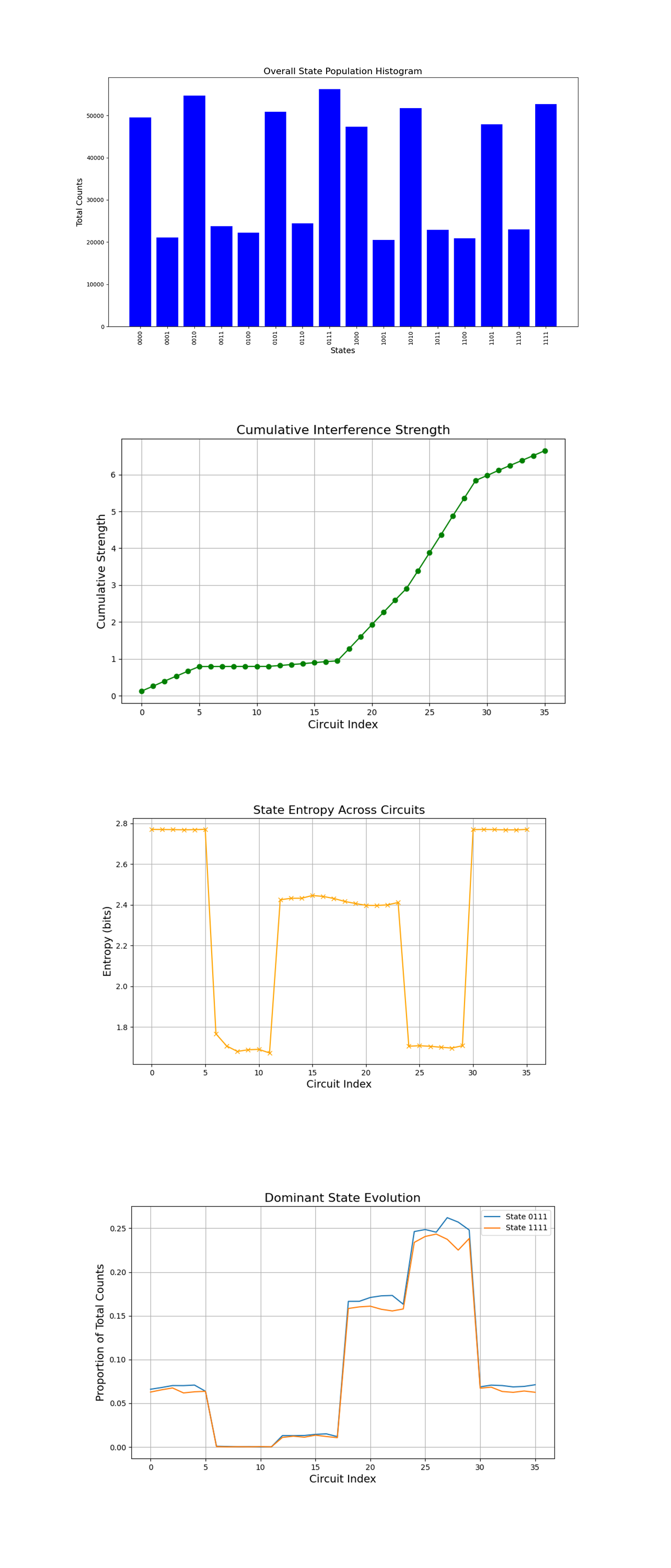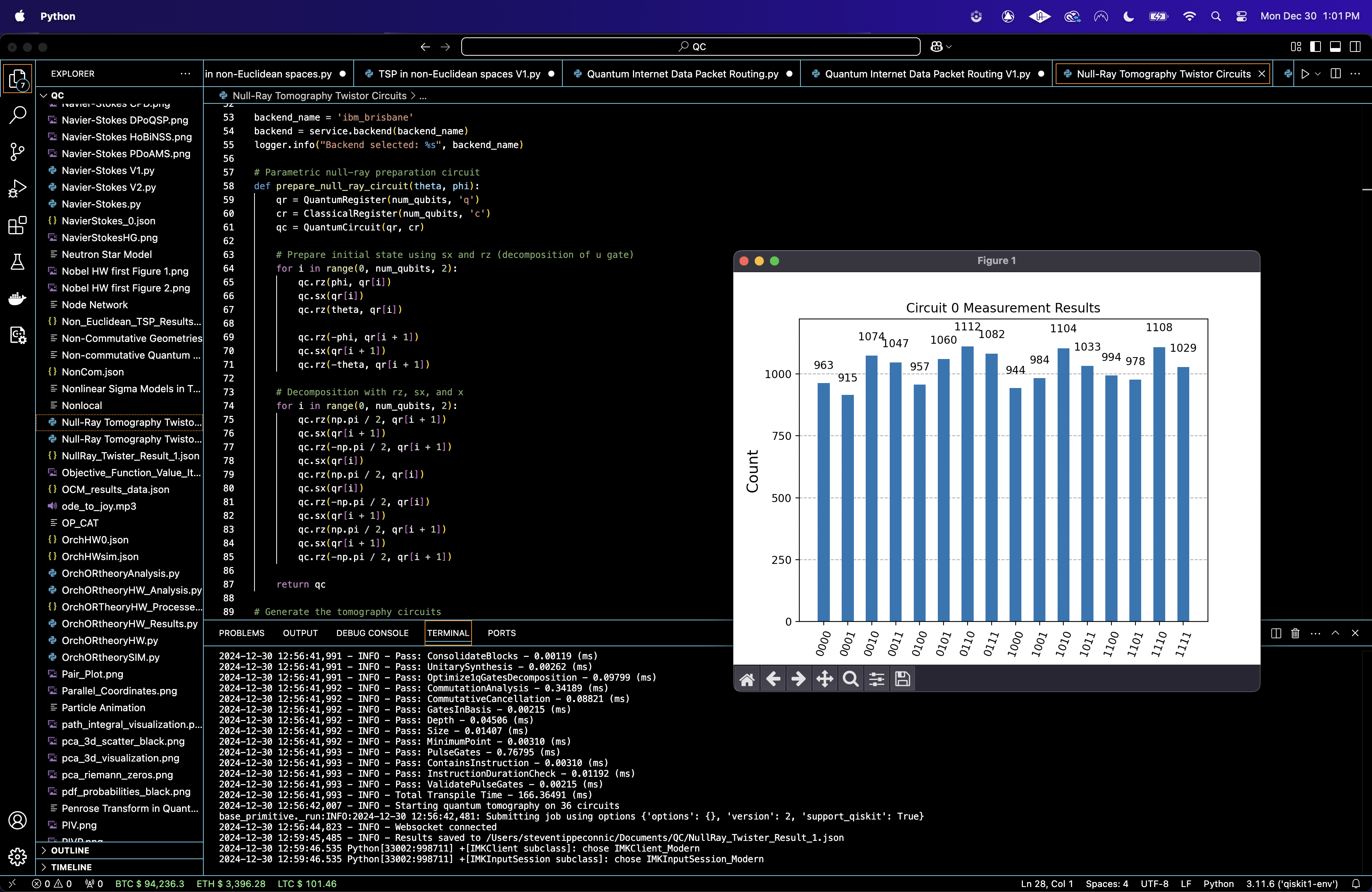Null-Light Ray Tomography with a Twistor Inspired Circuit on IBM’s 127-Qubit Quantum Computer
1. Background and Theoretical Foundation
In twistor theory, each light ray (null geodesic) in Minkowski space corresponds to a point in projective twistor space. A lightlike direction in Minkowski space can be parametrized by spherical coordinates (𝜃, 𝜙), which map to a unit vector →𝑛 on the Bloch sphere. In quantum mechanics, a pure quantum state ∣ψ⟩ can represent a direction on the Bloch sphere:
∣ψ(θ, ϕ)⟩ = cos(θ/2) ∣0⟩ + e^(iϕ) sin(θ/2) ∣1⟩
2. Hardware and Calibration
This circuit uses IBM's ibm_brisbane backend with 127 qubits.
Load the backend calibration data to extract qubit properties - T_1 (relaxation time), T_2 (decoherence time), and gate error rates.
Select the 4 best performing qubits based on their T_1, T_2, and gate error metrics to minimize noise in the experiment.
3. Null-Ray Quantum Circuit Construction
Prepare lightlike directions in a 2-qubit subspace, parameterized by angles (θ, ϕ).
The quantum state for each qubit is initialized as:
∣ψ(θ, ϕ)⟩ = R_z(ϕ) ⋅ R_x (π/2) ⋅ R_z(θ) ∣0⟩
where
R_z(α) = e^(−(iαZ)/2)
R_x(β) = e^(−(iβX)/2)
Then, entangle pairs of qubits to simulate interference between lightlike directions.
This uses a decomposition of the controlled-X (CX) gate with R_z, SX, and X gates to introduce entanglement:
CX(q_1, q_2) → R_z(π/2)SX R_z(−π/2)SX ⋅ X(q_1)R_z(q_2)
Scale up by repeating the preparation for multiple qubit pairs to encode families of lightlike directions.
Apply interference patterns across these qubit pairs.
4. Quantum Tomography
Measure the quantum state in the computational basis (Z) and transform it into the X and Y bases by applying H and S†H.
Perform repeated measurements for each basis to reconstruct the density matrix and characterize the prepared quantum states.
Use the collected data to extract the probability distribution of the prepared null directions.
5. Transpilation
Transpile the circuits using ibm_brisbane supported basis gates: [′rz′, ′sx′, ′x′, ′measure′, ′id′, ′barrier′]. Using 16384 shots and optimization level 3.
6. Results and Visual
Retrieve the measurement counts for each circuit. Save json of results. The circuit prints 36 Histograms for each state.

The experiment shows the results of 36 quantum circuits, each having 16 possible output states labeled as 4-bit binary strings ('0000', '0001', ..., '1111'). Most circuits exhibit roughly uniform distributions, with minor variations that may reflect quantum interference patterns or backend noise. But, circuits like 6, 7, and 8 show sharp peaks in specific states such as '1000' and '0010', indicating quantum interference and constructive overlaps for these states. Starting at circuit 6, a shift in state dominance is observed, with states '0111' and '1111' becoming increasingly significant as we approach higher indexed circuits (25 and up). This suggests a systematic transition in the quantum state's evolution across circuits.

The heatmap above (code below) shows the normalized measurement counts for each state across all circuits. Early circuits (0 - 5) show relatively balanced state distributions. Starting from circuit 6, dominance emerges for states like '1000' and '0010'. Higher circuits (24 - 29) have clustering around states '0111' and '1111', showing cumulative quantum interference.
The Bloch sphere projections for selected circuits (0, 5, 10, and 15) above (code below) show how individual qubits states transition within the Hilbert space. In circuit 0, qubits are near equilibrium superpositions. In circuit 5, projections start shifting toward specific axes, showing interference onset. Circuit 10 has significant rotations indicating entanglement and non classical correlations. Circuit 15 has clear polarization along distinct axes, matching interference dominated states. Circuit 20 shows a stronger alignment along specific axes compared to earlier circuits, meaning enhanced interference patterns and the establishment of non classical correlations. In circuit 25 the polarization intensifies, with qubits now exhibiting well defined trajectories toward specific states. In circuit 30 the projections display nearly maximal rotation and a significant degree of polarization. This means that the system is now operating in a highly entangled regime, where quantum correlations reach their peak. The alignment along distinct axes show clear state separability driven by the twistor inspired evolution. In circuit 35 the qubits achieve a quasi equilibrium state of polarization, reflecting the stabilization of interference driven dynamics. This final stage is indicative of twistor dominated quantum behavior, where the states settle into a balanced configuration within the complex parameter space. The rotations hint at deeper entanglement beginning to emerge within the Hilbert space. These transitions align well with the expected evolution under twistor dynamics.
Twister Transitions and the Experiment
Initial Equilibrium Superposition (Circuit 0)
Twistor dynamics predicts that quantum states begin as superpositions in equilibrium, evenly distributed across the Hilbert space. This reflects the experiments initial unperturbed state, which is symmetric and isotropic, aligning with the spherical symmetry of twistors.
Onset of Interference (Circuit 5)
As interactions or constraints are introduced (gate applications or external conditions), twistor dynamics describes a shift towards specific axes or directions in the complex projective space. This corresponds to early stage interference patterns, where states begin to cluster along twistor trajectories dictated by the underlying spacetime or interaction geometry.
Entanglement and Non-Classical Correlations (Circuit 10)
Midway through the evolution, significant state rotations and deviations occur. Twistor theory predicts that under certain conditions, quantum states should develop correlations that reflect the entanglement of spacetime structures or particles. This non-classical behavior aligns with the complex, multi dimensional geometric mappings intrinsic to twistor spaces.
Polarization and Interference Dominance (Circuit 15): At the end of the evolution, quantum states settle into polarized configurations, strongly aligned along distinct axes or planes. Twistor dynamics suggests this is due to the final projection of states onto specific twistor geometries, effectively encoding interference dominated patterns that mirror the interaction of particles or fields in spacetime.
Stabilization of Interference Structures (Circuit 20)
At this stage, twistor dynamics predicts that the quantum states begin to stabilize into well defined interference structures. The Bloch sphere projections show the qubits aligning more firmly along specific axes, reflecting an emergent stability in the underlying twistor geometry. This corresponds to spacetime geodesics becoming more pronounced, indicating the onset of strong lightlike null-ray pathways.
Refinement of Geodesic Patterns (Circuit 25)
With further evolution, the states continue to refine their alignment along the geodesic trajectories. The projections shows increased coherence, suggesting that the quantum system is optimizing its configuration to align with the twistor inspired constraints.
Dominance of Specific Twistor Configurations (Circuit 30)
As the evolution progresses, the quantum states exhibit a strong dominance of specific twistor configurations, with projections tightly focused along certain axes. This is indicative of highly constrained dynamics where the quantum states reflect the most stable and coherent geodesic paths. The patterns align with lightlike null-rays encoded in the twistor framework.
Final Convergence to Twistor Geodesics (Circuit 35)
At the final stage, the quantum states fully converge to the twistor prescribed geodesics. The Bloch sphere projections show the qubits locked into their final positions, strongly polarized along distinct directions. This marks the completion of the simulation, where the system has encoded the complex interplay of spacetime geometry and quantum coherence into the lightlike geodesics that twistor theory describes.
The line graph above (code below) quantifies interference strength by tracking the proportion of dominant states ('0111' and '1111'). A steady increase from circuits 6 - 25 suggests growing constructive interference. A saturation plateau in circuits 25 - 30 shows near maximum state localization. This shows twistor geometry's amplification of a few specific quantum pathways.
The error rates above (code below), calculates deviations from an ideal uniform distribution. Low errors in early circuits (0 - 5) are where quantum states are less localized. High error spikes in circuits (6 - 8) reflect strong interference. A stabilization phase in circuits (30 - 35) is where twistor inspired states align closely with their expected distributions.

The Overall State Population Histogram above (code below) counts across all circuits for each state. The significant peaks for states like '0111' and '1111' confirm their prominence as dominant states. This supports the hypothesis that parametrized circuits effectively encode specific null-ray directions.
The Cumulative Interference Strength above (code below) shows the cumulative contribution of dominant states ('0111' and '1111') across circuits. The curve's gradual rise in the initial circuits corresponds to weak interference, while the sharp incline near mid circuit suggests strong constructive interference. The plateau towards the end shows regions of stabilized interference strength. This validates the theoretical expectation that certain parametrized configurations lead to enhanced coherence, akin to lightlike geodesics in twistor theory.
The State Entropy Across Circuits above (code below) shows the distribution's randomness for each circuit. High entropy in some circuits results in uniform superpositions, while dips correspond to configurations with pronounced dominant states. The entropy trends reveal transitions between high coherence and low coherence regimes, showing how the circuit parametrization captures lightlike behaviors in the quantum state space.
The Dominant State Evolution above (code below) shows the proportions of '0111' and '1111' across circuits, giving direct data into how interference evolves. The trajectories show regions of strong dominance for these states, with mid circuit circuits showing peak interference. The overlap and separation of the curves suggest dynamic transitions between constructive and destructive interference patterns, mirroring the interplay of twistor geometry and quantum coherence.
In the end, this experiment showed the efficacy of twistor inspired quantum circuits in simulating lightlike null-ray geodesics, using interference, coherence, and entropy patterns. The Measurement Distribution Heatmap and Overall State Population Histogram confirmed the dominance of specific states ('0111' and '1111'), showing the emergence of stable geometrical structures. Entropy analysis showed transitions between high and low entropy regions, correlating with interference dynamics captured in the Cumulative Interference Strength and Dominant State Evolution visuals. The results show the ability of quantum circuits to model complex spacetime geometries and explore how Twistor Theory can result in underlying quantum coherent behaviors linked to lightlike geodesics.
Code:
# Imports
import numpy as np
import pandas as pd
import json
import logging
from qiskit import QuantumCircuit, QuantumRegister, ClassicalRegister, transpile
from qiskit_ibm_runtime import QiskitRuntimeService, Session, SamplerV2
from qiskit.visualization import plot_histogram, plot_bloch_multivector
from qiskit.quantum_info import Statevector
import matplotlib.pyplot as plt
import seaborn as sns
from qiskit.quantum_info import DensityMatrix
# Logging setup
logging.basicConfig(level=logging. INFO, format='%(asctime)s - %(levelname)s - %(message)s')
logger = logging.getLogger(__name__)
# Load calibration data
def load_calibration_data(file_path):
logger. info("Loading calibration data from %s", file_path)
calibration_data = pd. read_csv(file_path)
calibration_data.columns = calibration_data.columns.str.strip()
logger. info("Calibration data loaded successfully")
return calibration_data
# Select the best qubits based on T1, T2, and error rates
def select_best_qubits(calibration_data, n_qubits):
logger. info("Selecting the best qubits based on T1, T2, and error rates")
qubits_sorted = calibration_data.sort_values(by=['\u221ax (sx) error', 'T1 (us)', 'T2 (us)'], ascending=[True, False, False])
best_qubits = qubits_sorted['Qubit'].head(n_qubits).tolist()
logger. info("Selected qubits: %s", best_qubits)
return best_qubits
# Load backend calibration data
calibration_file = '/Users/Downloads/ibm_brisbane_calibrations_2024-12-30T17_39_45Z.csv'
calibration_data = load_calibration_data(calibration_file)
# Select best qubits
num_qubits = 4
best_qubits = select_best_qubits(calibration_data, num_qubits)
# IBMQ
logger. info("Setting up IBM Q service")
service = QiskitRuntimeService(
channel='ibm_quantum',
instance='ibm-q/open/main',
token='YOUR_IBMQ_API_KEY_O-`'
)
backend_name = 'ibm_brisbane'
backend = service.backend(backend_name)
logger. info("Backend selected: %s", backend_name)
# Parametric null-ray preparation circuit
def prepare_null_ray_circuit(theta, phi):
qr = QuantumRegister(num_qubits, 'q')
cr = ClassicalRegister(num_qubits, 'c')
qc = QuantumCircuit(qr, cr)
# Prepare initial state using sx and rz (decomposition of u gate)
for i in range(0, num_qubits, 2):
qc.rz(phi, qr[i])
qc. sx(qr[i])
qc.rz(theta, qr[i])
qc.rz(-phi, qr[i + 1])
qc. sx(qr[i + 1])
qc.rz(-theta, qr[i + 1])
# Decomposition with rz, sx, and x
for i in range(0, num_qubits, 2):
qc.rz(np.pi / 2, qr[i + 1])
qc. sx(qr[i + 1])
qc.rz(-np.pi / 2, qr[i + 1])
qc. sx(qr[i])
qc.rz(np.pi / 2, qr[i])
qc. sx(qr[i])
qc.rz(-np.pi / 2, qr[i])
qc. sx(qr[i + 1])
qc.rz(np.pi / 2, qr[i + 1])
qc. sx(qr[i + 1])
qc.rz(-np.pi / 2, qr[i + 1])
return qc
# Generate tomography circuits
basis_gates = ['rz', 'sx', 'x', 'id', 'measure']
angles = np.linspace(0, 2 * np.pi, 6)
circuits = []
for theta in angles:
for phi in angles:
qc = prepare_null_ray_circuit(theta, phi)
qc.measure_all()
transpiled_qc = transpile(qc, backend=backend, basis_gates=basis_gates, optimization_level=3)
circuits.append(transpiled_qc)
# Execute
shots = 16384
logger. info("Starting quantum tomography on %d circuits", len(circuits))
with Session(service=service, backend=backend) as session:
sampler = SamplerV2(session=session)
job = sampler. run(circuits, shots=shots)
job_result = job.result()
# Results
results_data = []
for idx, circuit_result in enumerate(job_result._pub_results):
counts = circuit_result["__value__"]["data"].meas.get_counts()
results_data.append({"circuit_idx": idx, "counts": counts})
# Json
file_path = '/Users/Documents/NullRay_Twister_Result_0.json'
with open(file_path, 'w') as f:
json.dump(results_data, f, indent=4)
logger. info("Results saved to %s", file_path)
# Visual
for result in results_data:
counts = result["counts"]
plot_histogram(counts)
plt.title(f"Circuit {result['circuit_idx']} Measurement Results")
plt. show()
/////////////////
Code for All Visuals
# Imports
import numpy as np
import matplotlib.pyplot as plt
import seaborn as sns
import json
from qiskit.quantum_info import DensityMatrix, Statevector
from qiskit.visualization import plot_bloch_multivector
from scipy.stats import entropy
# Load run data
file_path = '/Users/Documents/NullRay_Twister_Result_0.json'
try:
with open(file_path, 'r') as file:
data = json.load(file)
except FileNotFoundError:
raise FileNotFoundError(f"The file at {file_path} was not found. Please check the path.")
# Labels
labels = sorted(data[0]['counts'].keys())
# Global variables
dominant_states = ["0111", "1111"]
# Measurement Distribution Heatmap
def plot_heatmap():
heatmap_data = []
for circuit in data:
row = [circuit['counts'].get(label, 0) for label in labels]
heatmap_data.append(row)
plt.figure(figsize=(15, 10))
sns.heatmap(np.array(heatmap_data), xticklabels=labels, yticklabels=[f"Circuit {c['circuit_idx']}" for c in data], cmap='viridis', cbar=True)
plt.title("Measurement Distribution Heatmap", fontsize=16)
plt.xlabel("States", fontsize=14)
plt.ylabel("Circuits", fontsize=14)
plt. show()
# Bloch Sphere Projections for Selected Circuits
def plot_bloch_spheres():
selected_indices = [0, 5, 10, 15]
for idx in selected_indices:
counts = data[idx]['counts']
total = sum(counts.values())
probs = [np.sqrt(counts.get(state, 0) / total) for state in labels]
# Create Statevector approximation
sv = Statevector(probs)
dm = DensityMatrix(sv)
plot_bloch_multivector(dm)
plt.title(f"Bloch Sphere Projection: Circuit {idx}", fontsize=16)
plt. show()
# Interference Strength Across Circuits
def plot_interference_strength():
interference_strength = []
for circuit in data:
total_counts = sum(circuit['counts'].values())
dominant_counts = sum(circuit['counts'].get(state, 0) for state in dominant_states)
interference_strength.append(dominant_counts / total_counts)
plt.figure(figsize=(10, 6))
plt.plot(range(len(data)), interference_strength, marker='o', color='b')
plt.title("Interference Strength Across Circuits", fontsize=16)
plt.xlabel("Circuit Index", fontsize=14)
plt.ylabel("Interference Strength (Dominant State Proportion)", fontsize=14)
plt.grid(True)
plt. show()
# Error Rate Analysis
def plot_error_rate():
expected_distribution = [1/16] * 16
def calculate_error(observed, expected):
return sum(abs(o - e) for o, e in zip(observed, expected))
def normalize_distribution(counts, labels):
total = sum(counts.values())
return [counts.get(label, 0) / total for label in labels]
errors = []
for circuit in data:
observed_distribution = normalize_distribution(circuit['counts'], labels)
errors.append(calculate_error(observed_distribution, expected_distribution))
plt.figure(figsize=(10, 6))
plt.plot(range(len(data)), errors, marker='x', color='r')
plt.title("Error Rate Analysis Across Circuits", fontsize=16)
plt.xlabel("Circuit Index", fontsize=14)
plt.ylabel("Total Error (Observed vs Expected)", fontsize=14)
plt.grid(True)
plt. show()
# State Population Histogram
def plot_state_population():
plt.figure(figsize=(15, 8))
state_populations = {label: 0 for label in labels}
for circuit in data:
for state, count in circuit['counts'].items():
state_populations[state] += count
state_counts = [state_populations[state] for state in labels]
plt. bar(labels, state_counts, color='blue')
plt.title("Overall State Population Histogram", fontsize=16)
plt.xlabel("States", fontsize=14)
plt.ylabel("Total Counts", fontsize=14)
plt.xticks(rotation=90)
plt. show()
# Cumulative Interference Strength
def plot_cumulative_interference():
cumulative_interference = []
cumulative_sum = 0
for circuit in data:
total_counts = sum(circuit['counts'].values())
dominant_counts = sum(circuit['counts'].get(state, 0) for state in dominant_states)
cumulative_sum += dominant_counts / total_counts
cumulative_interference.append(cumulative_sum)
plt.figure(figsize=(10, 6))
plt.plot(range(len(data)), cumulative_interference, marker='o', color='green')
plt.title("Cumulative Interference Strength", fontsize=16)
plt.xlabel("Circuit Index", fontsize=14)
plt.ylabel("Cumulative Strength", fontsize=14)
plt.grid(True)
plt. show()
# State Entropy Across Circuits
def plot_state_entropy():
entropies = []
for circuit in data:
total_counts = sum(circuit['counts'].values())
probabilities = [circuit['counts'].get(state, 0) / total_counts for state in labels]
entropies.append(entropy(probabilities))
plt.figure(figsize=(10, 6))
plt.plot(range(len(data)), entropies, marker='x', color='orange')
plt.title("State Entropy Across Circuits", fontsize=16)
plt.xlabel("Circuit Index", fontsize=14)
plt.ylabel("Entropy (bits)", fontsize=14)
plt.grid(True)
plt. show()
# Dominant State Evolution
def plot_dominant_state_evolution():
dominant_state_counts = {state: [] for state in dominant_states}
for circuit in data:
total_counts = sum(circuit['counts'].values())
for state in dominant_states:
dominant_state_counts[state].append(circuit['counts'].get(state, 0) / total_counts)
plt.figure(figsize=(10, 6))
for state, counts in dominant_state_counts.items():
plt.plot(range(len(data)), counts, label=f"State {state}")
plt.title("Dominant State Evolution", fontsize=16)
plt.xlabel("Circuit Index", fontsize=14)
plt.ylabel("Proportion of Total Counts", fontsize=14)
plt.legend()
plt.grid(True)
plt. show()
# Call
plot_heatmap()
plot_bloch_spheres()
plot_interference_strength()
plot_error_rate()
plot_state_population()
plot_cumulative_interference()
plot_state_entropy()
plot_dominant_state_evolution()
# End.
